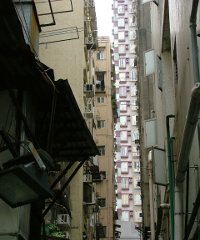In our previous article on the cost of living in Hong Kong we note that the annual living quarters allowance for US government expats in Hong Kong is a range around $100,000 (US). This translates to a monthly rate for rent/utilities of $7K to $10K, which would provide luxury living in most parts of the US and many large cities worldwide. That doesn’t mean, however, that the apartment will provide luxury amenities in Hong Kong. This rent will typically provide an apartment with a living area in the range of less than 2,000 sq ft in high-end areas in mid-levels, Parkview, South Island, and Discovery Bay. Floor space provided at this rate will be higher in Western, Kowloon, New Territories, and outlying islands.
What do these apartments look like?Starting with the kitchen, it will probably be smaller than in many US homes and have utilitarian appliances and no island or breakfast bar for gathering around while Mom cooks. In fact, many kitchens will not have an eating area at all; instead there will be some dining/breakfast area outside the kitchen door. The reason for this is that most expats will have a live-in servant in the form of an amah or helper. She will do all the cooking for three meals a day Monday to Saturday and also make meals and do the clean-up when you entertain guests. You personally will have no need for the large kitchen for cooking or entertaining since you will instead be engaging with guests outside the kitchen.
The amah will have a very small bedroom and toilet area, generally on the opposite side of the kitchen from the family quarters. This area is typically so small that it doesn’t hold a normal size twin bed, but amah beds up to a foot shorter than standard can be purchased. Any laundry facilities and trash collection will be in this area as well, possibly with a service elevator access. It is likely not to have heating or air-conditioning. This area is relatively small, but it is part of the overall apartment area reported.
The primary living area is likely to be one room large enough for a family room setup and dining area. This is the area that will have the premium view if there is one. If there is a balcony, it will probably be included in the square footage and is likely to be attached to this area. It will perhaps be large enough for a small grill and a couple chairs, but not likely a full outdoor dining set. Or it may be smaller, just large enough to set several potted plants outside.
The bedroom size will vary depending on the number of rooms. All non-masters are likely to be smaller than bedrooms now in vogue in the US. Hong Kong furniture sellers (e.g. IKEA) cater to folks with these small spaces by offering loft beds, especially for kids, with space underneath for desks or sitting/playing areas. There may be bathrooms for each bedroom or a common room for one or more non-master bedrooms. Any of these bathrooms are likely to have standard size shower/bath combinations.
The master bedroom may be utilitarian, not the large refuges now in vogue. Some will not even hold a king-size bed comfortably. There may be a small walk-in closet, but unlikely separate his/her closets. Even the master bath is likely to be functional rather than fashionable. Expect just one sink and a combination shower/bath, minimal extra space.
One of the biggest problems for expats is the lack of extra storage space. There won’t be extra closets, a basement, attic, or crawlspace for storing seasonal items. Some apartments will offer a lockable storage space separate from the apartment, perhaps at an extra fee. This may be located in the carpark or other public area and is a good spot to store bicycles and other outdoor hobby gear, empty suitcases, Christmas decorations, etc.
A car space, if available, will likely mean a sizable addition to the rent charges. Unless you find an actual house in New Territories or outlying islands, it’s very unlikely that you will have any yard. Gardening expats tend to maintain their hobby with houseplants and container plants that fit on the balcony.
If you end up trying to live more modestly you can get an apartment for $2,000 monthly but it will likely be significantly smaller than 600 square feet. Mong Kok in Kowloon has the densest population of anywhere in the world, with 130,000 people per square km (340,000/sq mile). Since this area was in the flight path of the old Kai Tak airport, many of the buildings here are 20 stories or less. That means the density comes not from huge high-rises on small bits of land, but from small apartments squeezed into the limited building space.
Whatever home you select, it’s important to check actual inside room dimensions. Some sellers and landlords report apartment size including non-usable space such as walls, pillars, and stair or elevator entrances, which can overstate livable space by as much as 50%. This over-reporting is expected to be declared illegal in 2013, but across-the-board enforcement will take some time.

